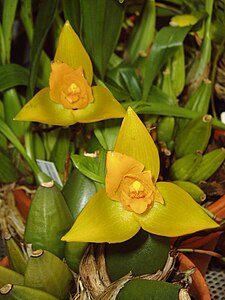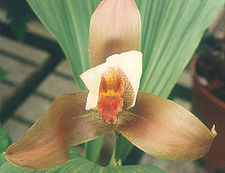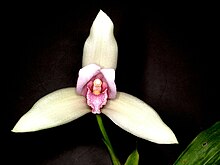|
Lycaste
Lycaste, abbreviated as Lyc. in horticultural trade, is a genus of orchids that contains about 30 species with egg-shaped pseudobulbs and thin, plicate (pleated) leaves. DescriptionLycaste flowers, like all orchid blooms, have three petals and three sepals. The petals are typically yellow, white, or orange, and the sepals are yellow, orange, green, or reddish brown. The petals and sepals may be marked sparsely or densely with red, reddish purple, purple, or reddish brown spots. The lip (ventral petal) may be very similar to the other two petals, as in Lycaste aromatica or Lycaste brevispatha, or colored quite distinctively, as in several subspecies and varieties of Lycaste macrophylla. Most Lycaste flowers are medium in size, averaging about 5 to 10 cm, but Lycaste schilleriana is 16–18 cm across. Some Lycaste blooms have a unique fragrance - the scent of Lycaste aromatica has been variously described as cinnamon or clove. The blooms of the species Lycaste cochleata, Lycaste consobrina, and Lycaste cruenta also have a pleasant scent. TaxonomyThe World Checklist of Selected Plant Families, maintained by the Royal Botanic Gardens at Kew, is recognized by the American Orchid Society as the definitive authority on orchid taxonomy. The Checklist currently acknowledges 31 species of Lycaste, 3 natural hybrids, 2 subspecies (and 1 nominate subspecies), and 1 variety. Orchid growers and orchid collectors, who tend to be taxonomic splitters more often than lumpers, recognize additional subspecies and varieties of Lycaste, as well as alba (white) forms of several species. SectionsThe Lycastes are divided into four sections and two subsections:
All but two of the Deciduosae have spines at the apices of their pseudobulbs, that become exposed when the leaves are dropped. The exceptions are the Xanthanthae species Lycaste lasioglossa and the Paradeciduosae species Lycaste tricolor. Both of these species lack spines, and may bloom when leaves are still present. List of species by section Xanthanthae
Paradeciduosae  Macrophyllae  
Fimbriatae Natural hybrids
Hybrids
A 2002 revision of the Lycaste genus moved many species of the section Fimbriatae to a new genus, Ida. The 34 species of Ida occur in South America and the Caribbean Islands (Ida barringtoniae), while true Lycastes occur mostly in Mexico and Central America. The genus Ida is recognized by the World Checklist of Monocotyledons. References
External links
|
||||||||||||||||||||||||||||||||||||
Portal di Ensiklopedia Dunia
